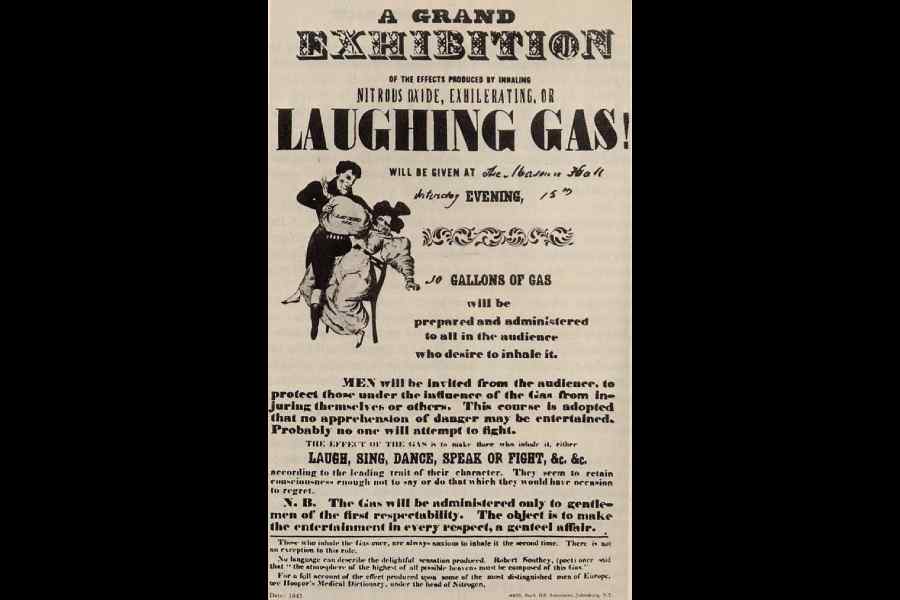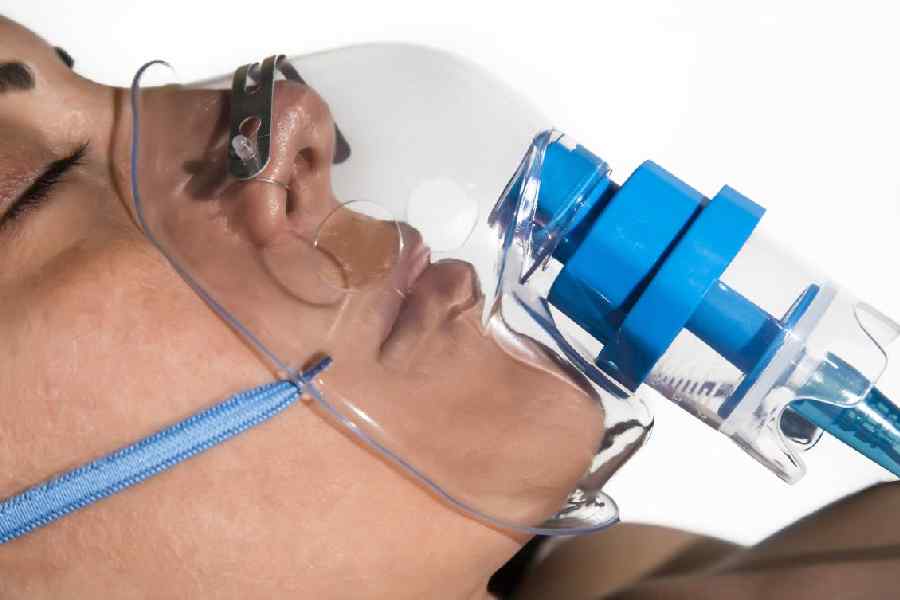For many, making a trip to the dentist’s can cause anxiety and fear. But advances in dentistry has led to creating a more relaxed and comfortable dental experience. We expect to feel no pain during any surgery and to have only a faint memory of the procedure.
A new age addition in making dental treatments comfortable is nitrous oxide sedation dentistry, often referred to as “laughing gas”. While nitrous oxide has been around for more than 200 years, the popularity of this as an adjunct towards pain-free dental treatments in India has been on the rise over the last decade.
In the 19th century it was called “laughing gas” as it had a giddy euphoric effect it had on those who inhaled it. In the 1840s, it became a fun thing at parties to laugh and dance and so on after inhaling it.

Laughing gas advertisement from the 19th century
At one such ‘exhibition’ a young man jumped about so violently that he injured his legs. He didn’t seem to mind the pain, though, and when he returned to his seat in the audience, a dentist in attendance by the name of Horace Wells took notice.
Wells had an epiphany and went back to his practice and immediately began using nitrous oxide on his patients after successfully extracting his own tooth under sedation. However, his public demonstration of nitrous oxide sedation failed. It took another two decades for a dentist to test nitrous oxide publicly again and few more decades after that for the practice to become widespread and effective.
The current practice of using a mixture of nitrous oxide and oxygen was introduced by Andrews in 1869. Today, nitrous oxide is widely used in dentistry.
Dentophobia, also known as odontophobia (fear of dentists) is an extreme fear that’s out of proportion to the situation. People with dentophobia avoid seeing the dentist even when they’re in pain. This condition is so severe that it can lead to very poor dental health.
Someone with dentophobia may be afraid of:
Anesthetic: People usually aren’t fearful of getting a local anesthetic (numbing drug), but instead, fear the anesthetic not working. Some people fear side effects of the anesthetic, such as temporary numbness of their lips.
Blood: Some people have a fear of blood (hemophobia). They may feel afraid or panicky about the possibility or actual presence of even minor bleeding that can happen during a dental procedure.
Choking: People may fear gagging or choking when the dentist numbs their mouth. They may fear not being able to breathe or swallow.
The dentist: People may associate negative feelings with their dentist. These feelings may be worse if they’ve had a bad experience with a dentist in the past.
Feeling pain: Dental procedures and recovery from these procedures may involve a certain amount of pain sometimes. People who’re highly sensitive to pain may be more fearful of feeling discomfort during their dental treatment or as a result of it.
Needles: People afraid of needles may fear the injections dentists use during dental procedures.
Noise: Someone may fear the noise made by drills and dental instruments used by the dentist or dental hygienist.
Smells: People may become anxious due to how the dentist’s office smells or the specific aromas that arise during dental treatment.
Possible causes of dentophobia
Family history: Your risk of having a phobia increases if you have a parent or family member with a phobic disorder or anxiety disorder.
Feeling embarrassed: You may feel strange about the dentist or hygienist being so close to your face. You may also feel worried about how your teeth look or how your breath smells.
Feeling helpless: The experience of lying in the chair and having your mouth open for an extended period can make you feel a loss of control.
Modelling: Hearing someone talk about their fear of dentists can spark the same phobia in you.
Bad experiences: People who have had a negative traumatic experience related to going to the dentist may develop dentophobia. Traumatic experiences may include being afraid of going to the dentist as a child, having dental procedures performed without your consent, or having a procedure that caused pain or complications.
Traumatic history: A history of abuse, such as bullying, child abuse or sexual violence, can lead to dentophobia.
Nitrous Oxide Sedation Dentistry
Nitrous oxide is a colorless and a sweet-smelling gas composed of nitrogen and oxygen. It has been used in the medical field for decades as a safe and effective way to alleviate anxiety and discomfort. In dentistry, nitrous oxide is administered through a mask that fits over the patient’s nose. The gas is mixed with oxygen and inhaled by the patient, inducing a sense of relaxation and easing dental-related stress and anxiety.
How It Works
Nitrous oxide works by slowing down the body’s stress response. It has a calming effect on the central nervous system, reducing the perception of pain and anxiety. You inhale nitrous oxide through a mask or nosepiece, and calming effects begin within three to five minutes. Your dentist controls the amount of sedation you receive and adjusts dosages accordingly throughout your procedure. Once your treatment is over, your dentist gives you pure oxygen to flush the nitrous oxide out of your system.
When inhaled, it creates a feeling of euphoria and relaxation, often leading to a sensation of “floating”. The patient remains conscious and able to talk and respond to the dentist’s instructions, making it an ideal solution for those with mild to moderate dental anxiety.
Inhalation sedation is one of the safest forms of sedation for both adults and children. It’s a moderate level of sedation, so you’re still technically awake but feeling very carefree. It’s sometimes called conscious sedation dentistry or “twilight sleep” because it creates a state of short-term amnesia where you experience insensitivity to pain without the loss of consciousness.
When can I eat?
You can eat and drink immediately after your appointment; though, most people prefer to wait until the numbness from the local anesthesia wears off. It’s best to start with something light, like clear liquids, and progress from there to a smoothie or milk shake. Your dentist will tell you what you can eat and when.
Benefits of Nitrous Oxide Sedation Dentistry
*Anxiety Reduction: Nitrous oxide is renowned for its ability to significantly reduce anxiety and fear associated with dental procedures. Patients who have had traumatic dental experiences or generalised anxiety find this technique particularly helpful.
*Fast Onset and Recovery: Patients typically feel the effects within minutes and return to their normal state shortly after the gas is discontinued. This is due to the rapid exit of the nitrous oxide from the body; 99 per cent of this gas is exhaled out quickly.
*Adjustable Dosage: The dentist can easily adjust the level of nitrous oxide to ensure the patient’s comfort throughout the procedure.
*No Lingering Effects: Unlike some other sedation methods, nitrous oxide wears off quickly after the gas is stopped. This means patients can even drive themselves home after the procedure.
*Suitable for All Ages: Nitrous oxide sedation dentistry is suitable for both children and adults. It’s a great option for pediatric patients who may have difficulty sitting still or co-operating during dental treatments.
Who Can Benefit?
*Dental Anxiety: Individuals with dental phobias or anxieties can benefit greatly from nitrous oxide sedation. It provides a sense of calm that helps alleviate their fears.
*Sensitive Gag Reflex: Patients with an overly sensitive gag reflex may find it challenging to undergo dental treatments. Nitrous oxide can help reduce the discomfort associated with this reflex.
*Low Pain Threshold: Some people have a low pain threshold, making even minor dental procedures uncomfortable. Nitrous oxide can raise their pain tolerance and make the experience more manageable.
*Long Procedures: Complex dental procedures that require extended periods in the dental chair can be physically and mentally taxing. Nitrous oxide offers relief during these lengthy treatments.
*People with Special Needs: Such patients can be managed comfortably with this technique.

Dr Kamlesh Kothari is an Oral and Maxillofacial Surgeon with a special focus on advanced dental and maxillofacial implantology. He is the director of Aesthetica - Advanced Dental and implant clinic at Vasundhara, 2/7 Sarat Bose Road, Calcutta. He can be reached at 9830183000, drkamleshkothari@gmail.com or www.aesthetica.co.in











